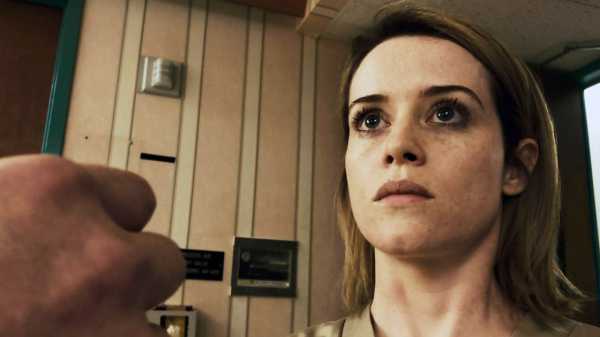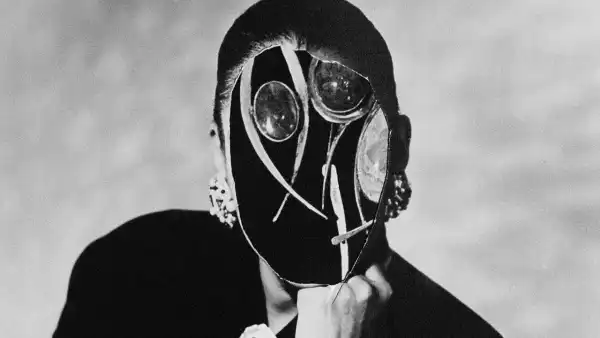
In his new film, “Unsane,” Steven Soderbergh has come close to the
cinematic equivalent of Flaubert’s dream of “a book about nothing.” The
subject of the film—a hectically intense thriller about a young woman
named Sawyer Valentini (Claire Foy) who has been the victim of a
stalker—is simply a pretext for a technical exercise: Soderbergh shot
the film entirely on an iPhone. But “Unsane” is also one of his best
movies, because for Soderbergh, a filmmaker with an obsessive devotion
to technique and process, there’s nothing impersonal or distanced about
that exercise; it’s the very spark of his artistic passion, and that
passion is the energizing force of “Unsane.”
At the beginning of the film, Sawyer is working as a financial analyst
somewhere in Pennsylvania, where she has recently moved, from her home
town of Boston, to get away from a stalker named David Shrine (played by
Joshua Leonard), who has been tormenting her. But Sawyer is still
suffering greatly from the experience and she sees a therapist to whom
she admits self-destructive impulses. Signing what looks like the
psychologist’s pro-forma document regarding treatment, she has actually
checked herself into a mental institution for a twenty-four-hour
observation. Sawyer finds herself held against her will in a nightmarish
facility that keeps patients confined for as long as their insurance
will pay; there, she’s terrorized by her fellow-patients (notably her
neighbor in the next bed, played by Juno Temple) Even worse, one of the
nurses turns out to be her stalker, and he inflicts further depravities
on her.
Yet “Unsane” is hardly about Sawyer, because there’s no substantive
Sawyer in the film for Soderbergh to make a movie about, and this
virtual elision of the character appears to be done by design.
Soderbergh approaches Sawyer merely as a collection of traits that
embody the idea of a victim of stalking; she is a character composed
solely of pieces that fit the needs of the story (albeit one who is lent
a formidable simulacrum of existence by Foy’s presence and energetically
expressive performance). For instance, she is an only child and her
father is dead, thereby leaving her with only one person to rely on in
an emergency—her mother, Angela (Amy Irving), who lives in Boston.
Sawyer goes utterly undefined, devoid of tendencies, thoughts,
interests, ideas, because she is, rather, the embodiment of an idea; the
protagonist of the film isn’t Sawyer or her stalker but stalking as
such.
Soderbergh doesn’t stretch to find any unexpected emotional twists,
byways, or ironies in this subject: it’s pretty obvious that stalking is
monstrous and evil, that enduring it is horrific and mind-warping. As
for the insurance-fraud angle, Soderbergh offers himself another
down-the-middle theme; the public
image of health-insurance companies is just a hair cleaner than that of
tobacco companies. The bare frame of the script (by Jonathan Bernstein
and James Greer) invites strong and simple emotional responses, on the
basis of obvious decency and empathy. (There’s also a twist that further
stokes responses, both emotional and political, involving Sawyer’s
fellow-inmate Nate, who is played by Jay Pharoah and who is actually an
undercover journalist.)
Soderbergh renders Sawyer cipher-like, leaves her without character and
personality; his approach to the phenomenon of stalking is distanced and
schematic. He doesn’t so much explore stalking, or even Sawyer’s
experience of it, as he relies on it as a mere framework—with one
exception. The scene that grabs Soderbergh dramatically is a peculiar
flashback (filmed from Sawyer’s point of view) involving a cameo by Matt
Damon as a police detective who, after Sawyer seeks a restraining order
against David, sits with her at home and enumerates, step by step, the
changes that she’ll have to make in her daily routine in order to stay
safe. He caps the lecture off with an offer of a book, “The Gift of
Fear,” by Gavin de
Becker. It’s the kind of scene that, were the fanatically
detail-and-process-oriented Soderbergh exploring Sawyer’s life and
experience, would have been turned into an extended sequence dramatizing
each of these changes and how she copes with them. Instead, it’s a scene
of talk, to which Soderbergh listens with an immediate curiosity,
intellectual focus, and dramatic surprise that outleaps that of most of
the high-pressured, often violent present-tense action of Sawyer’s
internment and efforts to escape.
With all that “Unsane” isn’t—and with all the flaws that those lacks and
deficiencies might seem to suggest—here’s what it is: Soderbergh’s
first-hand, physical, immediate expression of pleasure in the making of
a movie. Soderbergh has often done his own cinematography (under the
pseudonym of Peter Andrews) and his own editing (in the guise of Mary
Ann Bernard). He does so again in “Unsane”—but what makes “Unsane”
different from his other hands-on productions is his use of an iPhone.
Free of cumbersome
equipment,
Soderbergh wields his camera with the agility of a pencil flying along a
sketch pad. The unleashed potential for easygoing virtuosity and casual
expressivity is realized, long before the terrors and the chills, in
tense scenes of Sawyer’s daily life in and around her office (including
a scene of all-too-ordinary creepiness, in which her boss, a middle-aged
man, tries to lure her to take a business trip with him). Soderbergh
uses his phone as if it were a virtual 3-D camera—holding it low to let
otherwise innocuous objects loom ominously in the foreground while
leaving the background action busy and deceptively distant—and betrays a
similar exuberance in the editing room. (There’s an extraordinary scene
in which Sawyer is surreptitiously fed psychotropic drugs; Soderbergh
represents her panic-stricken derangement by means of double, or even
multiple, exposures that suggest both canny planning and free-handed
realization.) The subject and the characters of “Unsane” are, in effect,
laboratory samples of movie-like material that reveals its significance
and its substance by way of the theoretical and technical uses to which
Soderbergh puts it.
Soderbergh’s technical innovation and his vigorously imaginative
deployment of it are at the core of the tradition of independent
filmmaking. On April 8th, the centenary of the director and photographer
Morris Engel, Metrograph will show his three features, including the
first, “Little Fugitive,” which François Truffaut credited as a key
inspiration of the French New Wave. The movie, which Engel made in 1952,
with Ruth Orkin (they married in the course of production) and Ray
Ashley, is the story of a young boy in Brooklyn who, tricked into
thinking that he has killed his brother, flees home and reaches Coney
Island. For the purpose of this film, Engel, who did his own
cinematography, designed a 35-mm. movie camera to what he considered the
requirements of the project—a camera that was both lightweight and
didn’t need to be held up to his eye for framing. It hung from a strap
and he looked down at its viewfinder, allowing him to film
inconspicuously in public and to move both freely and unobtrusively.
(Jean-Luc Godard later wrote to Engel in the hope of borrowing the
camera, and, in the nineteen-seventies, he sought to produce, to his
specifications, a similarly lightweight and portable 35-mm. camera.)
“Unsane” is an experimental film in the fullest sense: taking a story of
plain and conventional simplicity, one that has clever but utterly
familiar twists and a direct and incontrovertible set of dramatic
tensions, he tries out a technique and finds that it gives rise to a
new, spontaneous style that reinvigorates and revitalizes his art, that
marks a sharp contrast with his own prior work and with Hollywood’s
conventional action dramas. Above all, he revels, with palpable joy, in
his repertory of distorted, disturbing, lurid yet lucid images, making a
furious movie that signifies nothing but the irrepressible vitality of
the cinema itself. Soderbergh’s experiment is a success. Now that he
sees his formula working, the question is: What will he do with it, how
will he use it non-formulaically?
Sourse: newyorker.com






